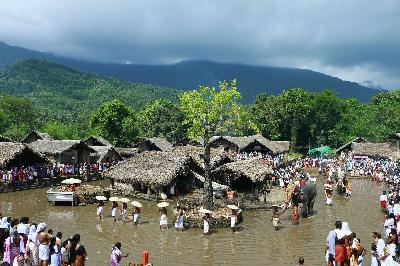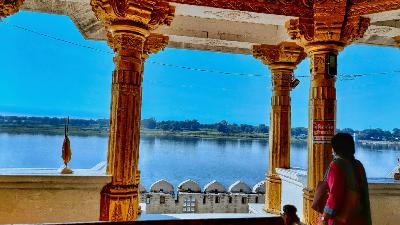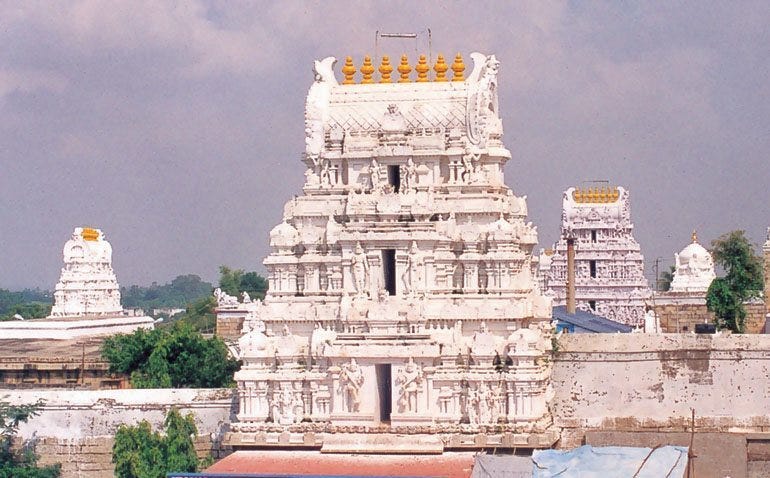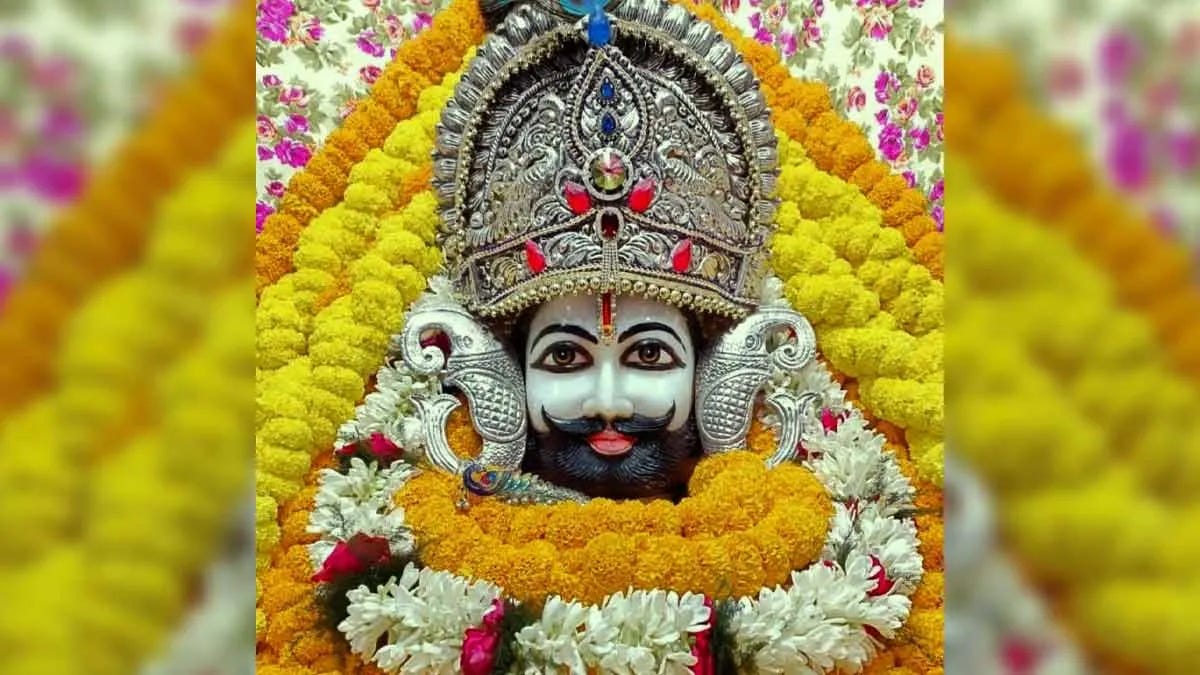Kottiyoor - The Sacred Forest Where Shakti Was Born
Description
The Hidden Cradle of the Divine Feminine
There are places in India where mythology doesn’t just live in stories - it breathes through the soil, whispers through the trees, and moves with the rhythm of the rivers. One such place is Kottiyoor, a small forest village tucked away in the lush highlands of Kerala’s Kannur district, bordered by the sacred Bavali River. To the uninitiated, it might appear as a remote shrine hidden in the folds of the Western Ghats. But to those who know its secret, Kottiyoor is nothing less than the spiritual birthplace of Shakti herself.
Long before stone temples rose across the land, before idols were carved or rituals codified, faith in Kottiyoor was shaped by nature itself. The air hums with devotion, the ground feels ancient, and the river carries echoes of an age when gods and mortals walked together. Locally called Vadakeswaram Temple, Kottiyoor is believed to be the very site of Daksha’s Yagna, the cosmic event that triggered one of Hindu mythology’s most powerful and sorrowful episodes - the self-immolation of Sati Devi and the subsequent creation of the 51 Shakti Peethas that sanctify the Indian subcontinent today.
This is not just a temple. It is a living memory of divine sorrow and transformation, of how destruction became creation, and how loss gave birth to the eternal presence of the Goddess. Every stone, every stream, every ritual in Kottiyoor is a continuation of that mythic moment - not preserved in scriptures, but lived through generations of worshippers, forest-dwellers, and spiritual seekers.
What makes Kottiyoor extraordinary is not its architecture, for there are no walls, no towers, and no golden domes. Instead, there is open sky, sacred earth, and an ancient rock where Sati is believed to have ended her life in protest. The shrine here is temporary, rebuilt each year for only 27 days, during which the forest transforms into a living Yagna ground. Priests, devotees, and tribal communities come together to reenact the cosmic event that forever changed the course of divine history.
In this timeless forest, ritual and myth are indistinguishable. The boundaries between history and faith fade away. Kottiyoor is not just a destination for pilgrims - it is an experience of spiritual rebirth, an immersion into the origins of devotion itself. It stands as a reminder that the essence of the sacred does not lie in monuments, but in moments - moments where the mortal meets the eternal, and where divinity reveals itself not in grandeur, but in simplicity.
The Mythic Origin: Daksha’s Yagna and the Birth of Shakti
The story begins with Daksha Prajapati, father of Sati and one of the sons of Brahma.Despite being Shiva’s father-in-law, Daksha harbored deep resentment toward him - considering Shiva an ascetic unworthy of his daughter.
When Daksha organized a grand Yagna (sacrificial ritual), he deliberately excluded Shiva and Sati from the invitation. Sati, unable to bear this insult, went uninvited - hoping to reconcile. But Daksha’s mockery and blasphemy against Shiva enraged her. In divine grief and protest, she self-immolated in the sacred fire.
Shiva, upon hearing of her death, was consumed by sorrow and fury.He carried Sati’s lifeless body across the cosmos, performing the Tandava of Destruction. To stop the devastation, Lord Vishnu released his Sudarshana Chakra, cutting her body into 51 pieces, which fell across the Indian subcontinent - each place becoming a Shakti Peetha, sanctified by her divine presence.
And the very spot where it all began - the original fire, the original sacrifice - was Kottiyoor.
History and Legacy of Kottiyoor
The origins of Kottiyoor dissolve into the mists of antiquity, lying at the intersection of myth, ritual, and early civilization. Long before organized temple worship emerged, this forest in northern Kerala served as a sacred grove for elemental worship, where the forces of nature were venerated as manifestations of divinity. The rituals of fire, water, and sacrifice performed here bear striking resemblance to the proto-Vedic yagnas described in early Hindu texts, suggesting that Kottiyoor may have been one of the earliest surviving forms of Shaiva and Shakta worship in South India.
Local traditions link the site directly to the Daksha Yagna, the primordial cosmic event that led to the creation of the Shakti Peethas. But historians and anthropologists view it as an ancient center of forest ritualism, where indigenous tribes, particularly the Kurichya community, practiced a form of animistic devotion. The discovery of the bleeding rock - struck by a Kurichya hunter’s arrow - symbolizes the merging of tribal reverence with the wider Hindu pantheon, transforming a natural shrine into a sanctified temple. This incident, believed to mark the appearance of the Swayambhu Shiva Linga, remains the foundation of Kottiyoor’s living faith.
Over centuries, Kottiyoor evolved under the stewardship of various rulers and dynasties. The Kolathiri kings, who ruled much of northern Kerala, are credited with formalizing the Vaishakha Mahotsavam, ensuring the participation of diverse communities in the rituals. They provided protection and resources for maintaining the sanctity of the site while preserving its unbuilt form. Later, under the Zamorins of Calicut, the temple continued to receive royal recognition and patronage, though none dared alter its essential simplicity - an open shrine amidst trees, untouched by the grandiose architecture that characterized other temples of the era.
Religious reformers and scholars, including Adi Shankaracharya, acknowledged Kottiyoor as a site of immense spiritual potency. Shankaracharya’s decision to worship from across the Bavali River, rather than entering Akkare Kottiyoor, reflected both reverence and restraint - a recognition that certain spaces transcend ritual ownership and human boundaries.
Archaeological and cultural studies suggest that many of the temple’s customs predate even the classical Hindu period. The community-based structure of rituals, where artisans, farmers, priests, and tribal leaders all have hereditary roles, is an echo of ancient collective worship systems once prevalent in agrarian and forest societies. This continuity makes Kottiyoor not just a religious site, but a living ethnographic archive of Kerala’s spiritual and social evolution.
Today, Kottiyoor stands as a rare bridge between epochs - between pre-Vedic earth worship and modern Hindu devotion. It embodies the resilience of faith through time, surviving conquest, colonization, and modernity without losing its soul. The river still divides the sacred and the human; the forest still shelters the divine flame; and the rituals still echo the world’s first Yagna.
Kottiyoor’s history, therefore, is not a tale of kings or conquests, but of continuity - of a land that refused to let the sacred fade into myth, choosing instead to let it live, breathe, and renew itself with every generation.
The Twin Shrines: Ikkare and Akkare Kottiyoor
Kottiyoor is uniquely divided by the Bavali River, symbolizing the split between the human and the divine.
Akkare Kottiyoor - The Forest Shrine
Accessible only for 27 days a year, beginning on the Swathi Nakshatram in the Malayalam month of Idavam (May–June), Akkare Kottiyoor is considered the site of the original Yagna.There are no permanent structures here - only temporary thatched huts and natural rock formations. The main sanctum, Ammarakalu Thara, is a raised rock believed to mark the exact spot where Sati immolated herself.
Even the presiding Shiva idol here - said to be discovered centuries later by a tribal youth when his arrow struck a bleeding rock - is worshipped only during these 27 days of divine reenactment.
Ikkare Kottiyoor (Thricherumana Temple) - The Eternal Shrine
On the other bank stands the year-round temple, consecrated by Lord Parasurama, an avatar of Vishnu. This temple is where daily rituals and prayers continue through the year, serving as the accessible face of the deeper sanctity beyond the river.
A Living Ritual: Communities and Sacred Duties
Unlike most temples, Kottiyoor’s rituals are not conducted by a single priestly order. Instead, they are collectively managed by diverse communities, each entrusted with hereditary responsibilities that have been passed down through countless generations. This collective stewardship reflects the very spirit of the Yagna - the coming together of many hands and hearts in service of the divine.
The Asari community is responsible for marking the sacred boundaries of the Yagna grounds, ensuring that every space within the forest is ritually purified and delineated for divine activity. The Kaniya community brings the ceremonial umbrellas used in processions, symbolizing protection and reverence. The Nair community carries the sacred ghee used for the Abhishekam, while the Theeya community offers coconuts, a gesture of purity and sacrifice. The Chaliya community provides the lamp wicks that illuminate the shrine, keeping the sacred flame alive throughout the rituals. Finally, the Kurichya community performs the very first Abhishekam, a deeply symbolic act that honors their ancestral legacy - for it was a Kurichya youth who, long ago, rediscovered the dei












